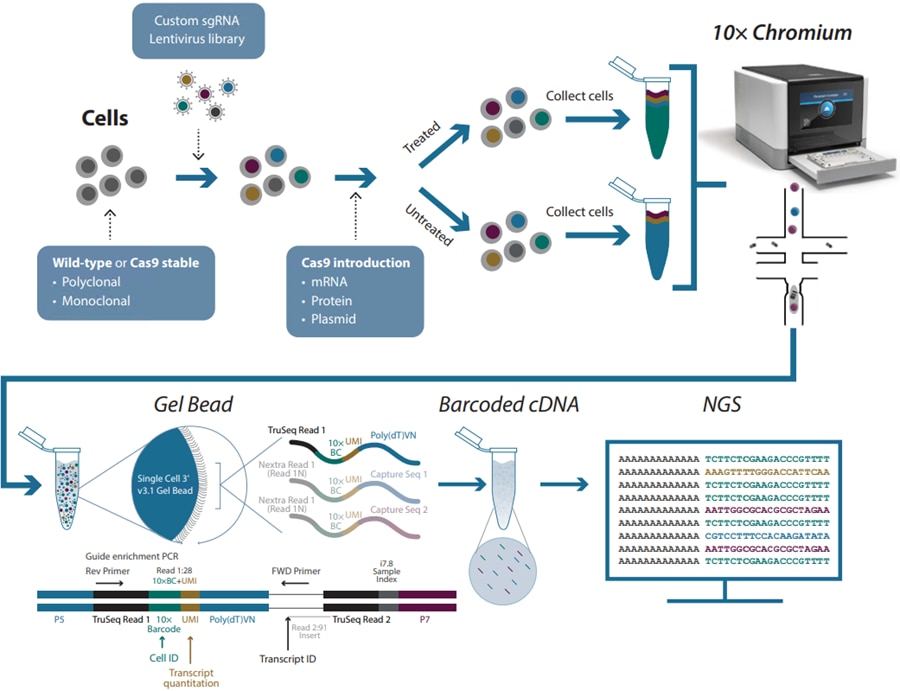CRISPRsc (CRISPR single cell) screening combines the flexibility of pooled screening with the power of transcriptomics at single cell resolution. By linking a specific guide RNA to single cell's whole transcriptome readout, CRISPRsc offers the opportunity to interrogate the phenotype of any given genetic perturbation in unprecedented detail.
Horizon’s CRISPRsc screening platform (Figure 1) offers a streamlined approach to elucidating valuable and intriguing biological information. One of the great advantages of CRISPRsc screening is the possibility to analyze datasets in the more traditional pooled screening, and in the single cell screening paradigms, for data comparison. Pooled analysis of whole transcriptome sequencing data can identify hits that are up- or down-regulated in response to a treatment and can help to verify screen performance if the treatment is known to exert a certain response (e.g. change in gene expression).

CRISPRsc workflow
Pooled lentiviral screening with CRISPR-Cas9 has significantly enhanced how researchers go about elucidating biological pathways, phenotype drivers, and therapeutic discovery and has evolved to become a fundamental aspect of research and discovery efforts in numerous fields. Pooled CRISPR screens offer a relatively fast, cost effective, and precise methodology to determine drug mechanism of action and to identify genetic resistance and sensitizing factors that enable patient stratification. Further, they enable a straightforward way to study gene-gene interactions and determine critical nodes in biological pathways and processes.
The limitations of pooled CRISPR screening
Though powerful in its own right, pooled CRISPR screening is often restricted to the measurement of a single phenotype such as proliferation or cell survival, or simple phenotypic changes, such as, measurement of changes in activity of a single gene through the generation of a reporter cell line. Recent publications have demonstrated the feasibility of coupling pooled CRISPR screening to highly complex readouts, such as single cell gene expression profiling. It is widely appreciated that groups of cells, even in culture, can display high levels of heterogeneity and this can result in wide ranges of response within the larger population. Similarly, high levels of cell heterogeneity are also observed in cancer cell lines and results in altered drug resistance or immune response.
The development of a powerful hybrid approach, pooled CRISPRsc screening
To better understand drug responses and the occurrence of treatment resistance it is paramount to investigate the underlying mechanisms at single cell resolution. By probing the transcriptome of each individual cell for its response to a treatment or a stimulus, we can link gene expression signatures with drug responses which enables the detection of biomarkers and the development of personalized medicines. CRISPRsc (CRISPR single cell) combines the flexibility of pooled screening with the power of transcriptomics at single cell resolution. By interrogating the effect a specific guide RNA to single cell whole transcriptome readout, CRISPRsc offers the opportunity to interrogate the phenotype of any given genetic perturbation in unprecedented detail. This allows identification of nuanced cellular responses that are integral to solving complex biological questions. Horizon’s CRISPRsc screening platform (Fig. 1) offers a streamlined approach to elucidating valuable and intriguing biological information. One of the great advantages of CRISPRsc screening is the possibility to analyze datasets in the more traditional pooled screening and in the single cell screening paradigms for data comparison. Pooled analysis of whole transcriptome sequencing data can identify hits that are up- or down-regulated in response to a treatment and can help to verify screen performance if the treatment is known to exert a certain response (e.g. change in gene expression). While the single-cell results allow identification of nuanced cellular responses that are integral to solving complex biological questions.
Whether your focus is target validation of drug therapies, analyzing cell differentiation, or another complex biological process, we're happy to discuss how this approach can take your research to the next level. Contact our team to arrange a consultation today.
 Written by Dr. James Goldmeyer, Product Manager
Written by Dr. James Goldmeyer, Product Manager
James has led the development and commercial launch of numerous product lines in his extended service with the company. He currently has responsibility for the Functional Genomic Screening services and is heavily involved in the development of novel applications and screening paradigms to support client research efforts. James works closely with an expert group of R&D scientists on innovative tools and services for gene modulation and engineering. James earned a doctorate degree in physiology and neurobiology at the University of Connecticut.
Learn more about the development of Horizon's CRISPRsc platform
Questions?
